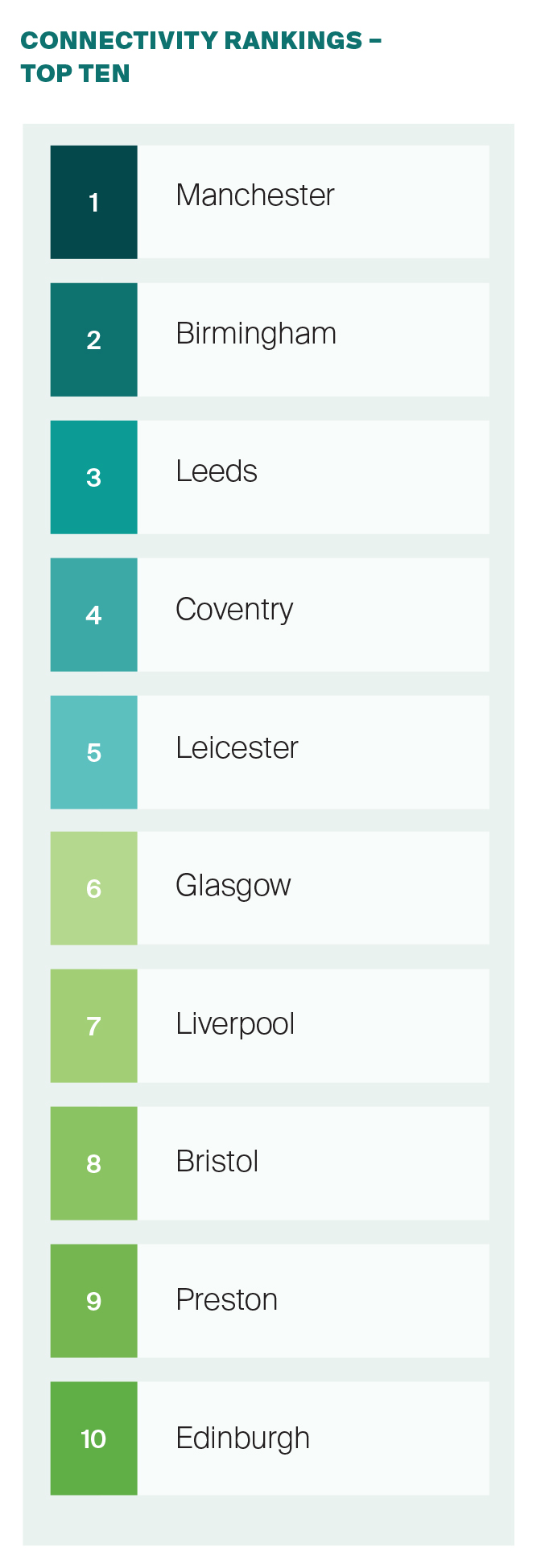Infrastructure - the arteries of growth
The interaction between people and technology are critically important to organisations in the realisation of ambitions. Which cities best demonstrates the principal components of this relationship?
4 minutes to read
Connectivity underpins all aspects of the efficiency and prosperity of a city. The degree of accessibility of a location is proven as a vital component that supports economic and social development.
The employment potential of a city is dependent on the extent of the talent pool it is able to draw from. The ease of travelling to a location significantly impacts access to local talent and the number of people willing to consider an area for work purposes. Accessibility is therefore fundamental for job creation, widening talent supply and ultimately boosting the potential for inward investment.
The role of digital connectivity most recently, has also grown in stature. Digital infrastructure is a key element of the future workings of a city, with harnessing the power of data in particular, an objective that appears on every local plan. Creating an extensive and resilient digital network has become a primary goal of both central and local authorities, with the UK Government committing in the 2020 Spending Review to investing £5bn in a ‘Gigabit-capable’ broadband rollout by 2025.
But has the pandemic sped up the urgency?
Covid-19 has forced organisations across the spectrum to re-evaluate both near and long-term business strategy. Central to the debate has been, and continues to be, the role of the workplace. Leveraging digital services during the pandemic protected the workforce and maintained business continuity. As greater freedoms are realised though, firms are understanding the shortcomings of operating remotely from the workplace long term, but equally are needed to prepare for the next ‘black swan’ event.
The sharp rise in employees working, learning and socialising online during the pandemic offers first hand evidence of how vital digital connectivity is to business survival and the future direction of business focus. People are now connected to real time information every minute of every day and equally require immediate service. The objective moving forward will therefore be to achieve a frictionless interrelationship between people and technology to improve service delivery and ultimately bolster operational resilience.
So what will future business strategy entail?
While every business is different, organisations will seek to reinvent and redefine working practices by utilising the positive aspects of hybrid models. The way firms consider spaces, meetings, travel, events and importantly, the work/ life balance of employees will be foremost. Flexibility and inclusivity will be primary. This shifting dynamic brings greater consideration of the connectivity attributes of specific locations, both physical and digital.
Our unique research explores the connectivity attributes, both digitally and physically, across the key markets outside of London and SE region. In its creation, we examined 17 metrics across 39 locations, generating over 800 data points which were equally weighted to assess the digital and physical strengths of each location. These include:
DIGITAL
Fibre availability, capacity and performance. Mobile network capabilities and proximity to data centre services. Whilst the importance of each component will be weighted differently according to organisation, each play a key role in creating a resilient digital platform and therefore shaping future business strategy.
PHYSICAL
Access to labour. The accessibility of a location remains vital to fully leveraging the availability of skilled staff and also tapping into the next wave of new talent. We have explored the demography of each location using defined travel times.
Investment is ongoing in support of the UK Governments ambition to create a ‘world class’ digital infrastructure. Currently, the UK performs well on digital connectivity measures compared to other countries, but the advancement of new technologies is quickening. Forecasts indicate that business transformation spending will increase by 15% in 2022. Consequently, business focus on the digital connectivity capabilities of cities will intensify in unison. Significantly, firms are looking beyond digitalisation as just a survival mechanism and are increasingly accelerating the role of digital or digitally enhanced service offerings. The rollout of new and more extensive networks of full fibre and 5G networks underpin these ambitions of growth.
Without doubt, the world of work is changing. Next wave technologies are emerging and the war for talent is intensifying. This will not only change the future form, function and location of the workplace, it will alter how we interact, move around and do business. Combining both physical and digital components provides a rounded assessment of the connectivity attributes of locations across the UK. Understanding and harnessing these two important components of the changing business landscape, will increasingly be seen as a significant area of differentiation in optimum location choice.

Download UK Cities 2022